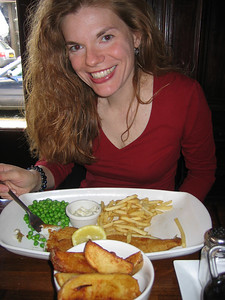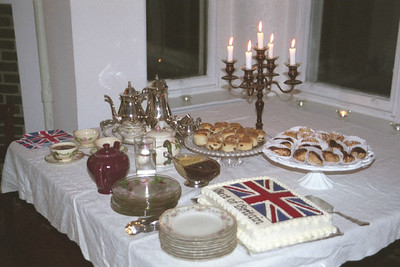When planning a global cuisine-themed party, I can think of no better land to honor than Great Britain. No doubt some will assume that I am joking, displaying a wicked sense of humor. British cuisine? Does the United Kingdom even have culinary customs beyond dry tea sandwiches, the ubiquitous fish, peas and chips and standard “meat and two veg” dinners which the previous meal so aptly represents? After five trips through the UK and more than a few meals consumed in this region, I can attest that British fine dining is alive, well and worth celebrating.

Have doubts? Recall Fergus Henderson, founder of London’s St. John restaurant and author of the seminal “Nose to Tail Eating.” An advocate of using the whole animal when cooking, the bespectacled Henderson has made consuming offal cool.
Then there are the celebrated British food writers and chefs. Elizabeth David. Delia Smith. Jamie Oliver. Nigella Lawson. Their consumer-friendly cookery books have sold millions in the UK as well as the U.S.
Let’s not forget Gordon Ramsey. Along with his riotous reality shows “Hell’s Kitchen,” “Ramsey’s Kitchen Nightmares,” and “The F-Word,” Ramsey has 3 Michelin stars to his name. Last year he took Manhattan by storm with Gordon Ramsey at the London on W. 54th.
Not sold yet? Well, you can thank the Brits each time you enjoy upscale restaurant fare at a downscale bar. Started in London in the 90’s, gastropubs featured gourmet takes on basic pub grub. The customary bangers and mash turned into venison sausage with sweet potato puree. Today at the Spotted Pig in the West Village you can get a bowl of smoked haddock chowder with homemade crackers or chargrilled burger dressed with Roquefort cheese. So much for the old pasty clam chowder and greasy cheeseburger.
Don’t forget all the fabulous, uniquely British imports. Sticky toffee pudding. Custard and fruit-filled trifles. The banana and toffee combo “banoffee pie.” Meaty Shepherd’s and cottage pies. Cornish pasties. And, England’s Indian-inspired national dish, chicken tikka masala.
So, what do famous British chefs, gastropubs and English recipes have to do with party planning in North America? Food, lots of glorious food.
At last summer’s “Best of Britain” soiree I filled chafing dishes with curry-scented chicken tikka masala, cardomom-infused basmati rice and garlic pea puree, my take on English peas. I then set out platters of crisp, thickly-cut chips (a/k/a French fries), cod filets and moist tea sandwiches of cheddar and mango chutney, cucumber and butter and smoked salmon and cream cheese. I also covered a cutting board with Stilton, Caerphilly and Huntsman cheeses. The featured cocktail was Pimm’s Cup, the spicy, citrusy English spirit mixed with lemonade, ice and mint leaves.
Guests noshed while grooving to the sounds of the Sex Pistols, Clash, Go! Team, Stones, Elvis Costello, Oasis, New Order and the Police. Best of Britain indeed.
Before serving dessert, I pitted friend against friend in a battle of wits and witticisms. “Name that British icon/event” forced contestants to think back to European history and British literature classes, old episodes of Monty Python and their days as Doc Martin-wearing, Mohawk-sporting punk rockers and come up with arcane facts about Great Britain. Winners took home such prizes as a 6-pack of Young’s, a teapot, box of Barry’s tea and bag of Bounty candy.

Game finished, the victors and vanquished dined on English breakfast tea and scones slathered with strawberry preserves, lemon curd and clotted cream. They also nibbled on miniature eclairs and cream puffs and a chocolate “Best of Britain” sheet cake.
At the end of the night everyone agreed. Fine British cuisine is definitely not the oxymoron that the uniformed think it to be.
Garlic Pea Puree
Inspired by a recipe in Nigella Lawson’s “How to Eat”
Serves 4 to 6
Ingredients:
10 cloves of garlic, skins removed
6 cups frozen peas
6 tablespoons unsalted butter
4 tablespoons creme fraiche
white pepper, to taste
Put the garlic in a large saucepan of water and bring to a boil, boiling for 10 minutes.
Add the peas and boil until soft.
Drain the peas and garlic then tip into the bowl of a food processor. Add the butter then process, leaving a chunky mixture.
Add the creme fraiche and process again, leaving peas nubbly-looking. Add pepper if desired and serve.
Buttermilk Scones
From Trudi Styler’s and Joseph Sponzo’s “The Lake House Cookbook”
Makes 6
Ingredients:
1½ cups plus 2 tablespoons all purpose flour
2 teaspoons baking powder
½ teaspoon salt
¼ cup unsalted butter, diced
⅓ cup raisins
¼ cup superfine sugar
½ cup buttermilk
beaten egg, for glaze
Preheat the oven to 450 degrees Fahrenheit.
Sift the flour, baking powder and salt into a large mixing bowl. Using your hands, rub the butter into the flour mixture until it resembles coarse bread crumbs.
Add the raisins and sugar and stir to combine.
Make a well in the center then stir in just enough buttermilk to form a soft dough.
On a lightly floured work surface turn out the dough and knead lightly. Roll the dough out to 1-inch thick and cut into rounds with a 2½-inch plain, round cutter. Transfer the rounds to a baking sheet lined with parchment paper or a Silpat mat.
Using a pastry brush, brush the tops of the scones with egg. Place the baking sheet in the oven and bake the scones for 7 to 10 minutes, until risen and golden brown on top.